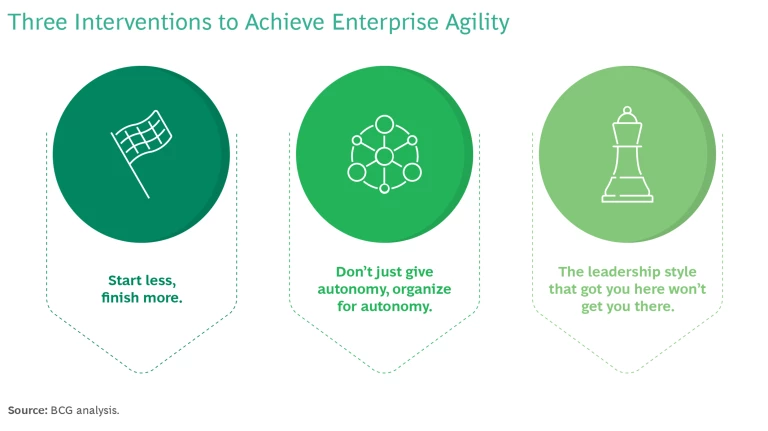Merely adopting scrum and organizing teams into squads has not delivered on the promise of increased agility that so many organizations hoped for.
The So What
When companies decide to change their ways of working, they tend focus most of their effort on adopting agile ceremonies, such as sprints, standups, and retrospectives, as these are highly visible and easy to implement.
Yet true enterprise agility demands a transformation of the entire operating model.
Without adapting the entire operating model, they typically run into the following problems:
Lack of Alignment on Priorities. Pursuing too many priorities in parallel leads to fragmentation, frustration, and decreased agility. All too often, organizations have a comprehensive strategy and vision but fail to prioritize the initiatives that will deliver real-world impact. As a result, too many initiatives are launched in parallel. It is easy to share a top-down agenda, but more difficult to create alignment around a shared agenda, and even harder to stop working on outcomes that have been deprioritized.
Limited Autonomy. When people work within organizational siloes and teams are stymied by complex interdependencies, they can’t deliver value quickly. Even when practices like scrum or kanban are adopted effectively by individual teams, if dependencies with other teams have not been minimized, progress will stall.
Counterproductive Leadership Behaviors. The traditional command-and-control approach slows down the empowerment and effectiveness of agile teams. Leaders often rise up through the ranks because they have mastered command-and-control tactics, but enterprise agility requires leaders to behave differently.
Now What
When done right, enterprise agility offers enormous benefits: doubling speed to market, tripling customer satisfaction, and quadrupling responsiveness to change. Here are the top three interventions to achieve enterprise agility. (See the exhibit.)

Start less, finish more. To do this, the organization must pursue both vertical and horizontal alignment. The goal of alignment is to create cohesion around the company’s priorities, objectives, and resources—both vertically (all teams, from top to bottom, share the same priorities) and horizontally (interdependencies between teams are systematically removed).
The vertical alignment is fostered through an unbroken chain of why that articulates the links between the overarching business outcomes that the company needs to achieve and the work that individual teams are charged with delivering. Every employee, at every level of the organization, should be able to say what they are doing and how that contributes to the overall objectives.
To reinforce the chain of why, teams should be judged on the value they deliver, not milestones. Establishing annual and quarterly business reviews helps organizations to evaluate their progress toward goals and change direction when needed. These mechanisms connect people’s day-to-day work to desired business outcomes and pave the way for lasting change.
Don’t just give autonomy, organize for autonomy. To deliver speedy results, teams require maximum autonomy. Autonomy is not something that can be decreed. Companies must organize in ways that overcome the potential barriers and roadblocks their teams will face, eliminate unnecessary handoffs, and reduce interdependencies. The goal is to enable small, dedicated, empowered, and multidisciplinary teams to handle their tasks independently from beginning to end. Still, no matter how well you structure the organization, some dependencies will always exist—but various mechanisms, such as cross-functional teams, can gradually reduce those dependencies.
Especially as agility scales across the organization, teams must be able to build, test, deploy, and pivot solutions as autonomously as possible. This is when a modular technology architecture and a platform operating model become increasingly important; therefore, achieving enterprise agility typically also requires a technology transformation.
The leadership style that got you here won’t get you there. Leaders need to set a clear vision up front—and then let go and trust their teams to get the job done.
Leaders need to embrace three behaviors:
- Foster trust and transparency. Move away from a command-and-control culture that demands more detailed milestones and updates.
- Be crystal clear on priorities. Then focus on creating alignment and autonomy across the whole organization.
- Start small, iterate continuously, and create value quickly. Move away from the tendency to launch big projects, executed perfectly, with slow delivery.
Enterprise agility is a powerful solution for companies that want to succeed in an increasingly competitive environment. When the operating model supports alignment and autonomy among working teams, enterprise agility delivers extraordinary results.






